
views
Distract yourself.

Choose a soothing distraction, like quiet music. Watching a TV show or spending time with a friend or loved one can also help get your mind off how you feel. If talking makes you feel worse, you might ask a friend or relative talk to you while you listen, or have them read something to you. Stress and anxiety can cause nausea or make it worse. A soothing distraction will not only help take your focus off the nausea, but it will also relieve stress and help you relax.
Get fresh air.

Open a window or step outside for a few minutes. Being around bad smells or stagnant air can trigger or worsen nausea. Try to move to a well-ventilated area for a little while until you feel better. Turning on a fan can help disperse or draw away bad smells. If you can, get away from any irritants in your environment that could make your nausea worse, such as cigarette smoke or strong cooking smells.
Lie down until the feeling passes.
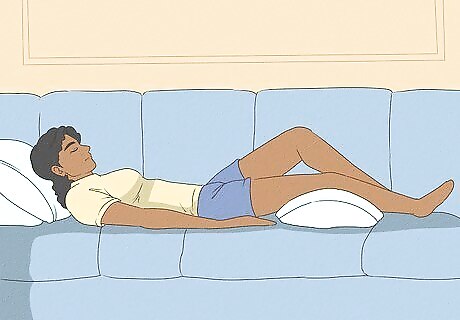
Lying down is especially helpful for motion sickness or vertigo. Find a comfortable spot and lie as still as possible. If motion sickness or vertigo is the problem, either close your eyes or look at a fixed point on the horizon until your stomach settles. Lying down can make some kinds of nausea worse. For instance, lying down too soon after eating can trigger nausea if you have acid reflux. If this is the case for you, try sitting still or propping yourself up on pillows instead.
Press on an acupressure point.
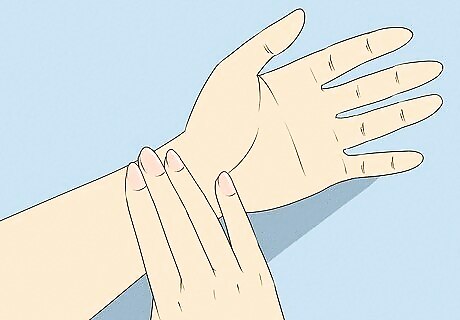
Gently massage the P-6 point on your wrist. While it’s not totally clear why it works, several studies have shown that acupressure is effective for reducing nausea. To find the P-6, or Neiguan point, hold your hand with your palm toward you and your fingers facing up. Put your thumb on the inside of your wrist, about 3 finger-widths below your palm, and feel for the space between the 2 large tendons that connect your wrist to your arm muscles. Gently press your thumb or index finger against this point for 2-3 minutes. Rub your thumb or finger in small circles while you apply pressure. Push down firmly, but not hard enough to cause pain. Move to the other wrist when you’re done. The space where your kneecap meets the top of your shin is another pressure point that’s thought to relieve nausea. It is known as the ST–36 point or Zu San Li. Consider seeing a professional acupressure or acupuncture therapist if you regularly struggle with nausea. They can also show you more techniques to use at home.
Do deep breathing exercises.

Slow, controlled breathing can calm your upset stomach. For a few minutes, take slow, deep breaths in through your nose and out through your mouth. To keep your breathing slow and steady, try counting slowly to 5 with each breath, and breathe out through pursed lips. Within about 5 minutes, you should begin to feel much better. To make sure you’re breathing deeply, put one hand on your chest and another on your belly. Concentrate on getting your belly to rise and fall as you breathe instead of your chest and shoulders. Some people find it helpful to breathe in a soothing scent, such as peppermint. However, studies show that deep breathing by itself is very effective at calming nausea.
Sip a cold drink.

Take small sips instead of big gulps. Cold, clear fluids, such as water, juice, a caffeine-free soda, or watered-down sports drinks are usually best. Take sips between meals or whenever you feel nauseated to help you stay hydrated and settle your stomach. If you’ve been throwing up, it’s especially important to drink lots of fluids so you don’t get dehydrated. Try to drink 6–8 cups (1.4–1.9 L) of fluid per day, unless your doctor has told you to drink more or less than that. Some people find warm drinks more soothing. Stick to mild, clear fluids, like plain broth or weak tea. You can also suck on ice chips, eat a popsicle, or eat some Jell-o. If you have a child who’s been vomiting, call their pediatrician for advice. Kids can get dehydrated more easily, so they might need something to help restore missing electrolytes, like diluted apple juice.
Drink ginger or peppermint tea.

Science shows that these old herbal remedies really work. Use a teabag to brew a cup of ginger or peppermint tea, or steep fresh ginger root or mint leaves in hot water. Take small sips so you don’t upset your stomach more. The aromas of ginger and peppermint may help calm nausea, so take a moment to breathe in the scent of your tea before sipping. If you find it hard to stomach hot liquids, let the tea cool off before you drink it. Ginger in other forms is also good for relieving nausea. For example, you can eat ginger cookies, suck on ginger candy, sip ginger ale, or take ginger in capsule form. If you use capsules, your doctor may recommend a taking 1000 mg split up over 4 doses throughout the day. Sucking on a peppermint candy or sniffing peppermint oil may also soothe your nausea.
Sniff a slice of lemon.

The smell of lemon can distract you from bad odors. If a bad smell is triggering your nausea, slice up a fresh lemon. Hold it close to your nose and breathe deeply to neutralize the unpleasant odor. The taste of lemon can also get rid of bad tastes in your mouth. If you’d rather not suck on a lemon, try a hard lemon candy or some lemonade.
Eat bland foods.
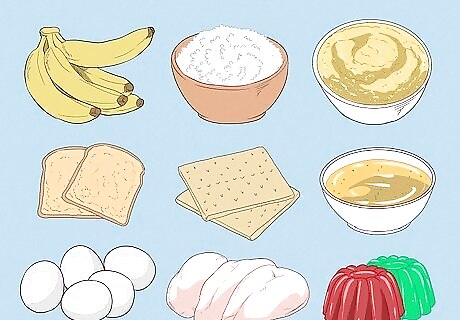
Stick to the BRAT diet to prevent stomach irritation. BRAT stands for bananas, rice, applesauce, and toast. In addition to these gentle foods, try other bland options, such as saltine crackers, plain potatoes, or clear broth. The salt on saltine crackers or pretzels may also help you feel better. If you’re hungry but don’t think you can handle solid foods, sip on broth or eat some Jell-o. Gradually work your way up to mild, protein-rich foods, such as chicken breast, fish, eggs, or yogurt. BRAT foods are also good for replenishing nutrients and restoring your energy after throwing up or having diarrhea.
Stick to small, frequent meals.

Eating too much at once can make nausea worse. On the other hand, having an empty stomach can also make you feel pretty terrible. Try to eat a small meal once every 1-2 hours. Take your time while you eat and sit down to rest for at least 30 minutes after each meal. Eating too fast or doing anything strenuous right after a meal can upset your stomach. When you skip meals, your blood sugar can drop too low—and that can make your nausea worse.
Eat a diet rich in complex carbs.
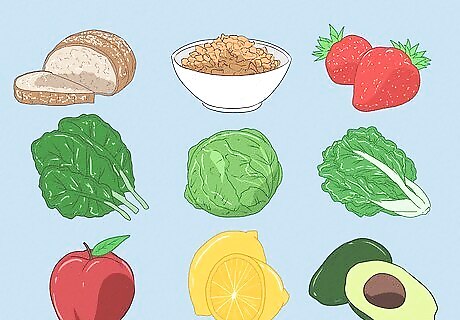
These foods are rich in nutrients and easy to digest. If you’re prone to nausea, go for foods like whole grain breads and cereals, leafy vegetables, and fresh fruits. These foods can be especially helpful when you’re suffering from morning sickness due to pregnancy. Dry carbs, such as dry cereal or toast without butter, are typically the easiest to handle.
Avoid greasy or spicy foods.
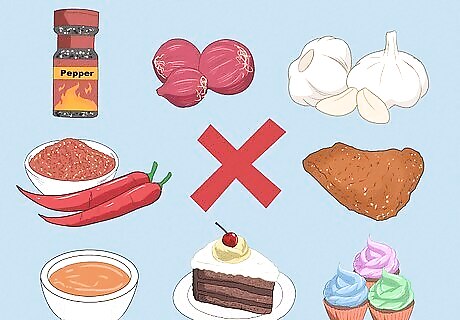
Fatty or heavy foods are harder to digest. Strong spices can also upset your stomach and make nausea worse. Until you’re feeling better, stay away from foods such as: Fried meats or eggs Gravy and heavy sauces Creams and cream-based dishes Onions and garlic Sweet baked goods and pastries, such as doughnuts, cakes, and cookies Spicy foods, like chili or hot sauce
Steer clear of alcohol, caffeine, and OTC painkillers.

These substances are all hard on the stomach. If you want something warm to drink, stick to herbal teas or broth instead of coffee. Avoid caffeinated sodas and anything with alcohol in it. Some over-the-counter medications, like aspirin, acetaminophen (Tylenol), and ibuprofen (Motrin), can also upset your stomach. Smoking can upset your stomach as well, so avoid cigarettes or marijuana if they make you feel sick.
Try a supplement if you have frequent nausea.

Ask your doctor to recommend a safe supplement. A few supplements that may help relieve nausea and vomiting include coenzyme Q10 (sometimes called CoQ10), L-carnitine, and riboflavin (vitamin B-2). Before trying one of these supplements, talk to your doctor. Tell them about any health conditions you have or other medicines and supplements you’re currently taking. Another promising supplement for reducing nausea is vitamin B6. Some studies show that B6 is as effective as ginger for treating nausea during pregnancy. If you’re struggling with morning sickness, ask your doctor to recommend a safe dose.
See your doctor for persistent or severe nausea.

Nausea can sometimes be a sign of a more severe problem. If you have nausea with or without vomiting and it does not go away within 24 hours, call your doctor for an appointment. If the nausea improves but you still have no appetite, have a headache, or have severe stomach or abdominal pain, call your doctor for advice right away. Go to the emergency room or call emergency services if you notice blood or a dark material in your vomit that looks like coffee grounds, or if you think your nausea was caused by poisoning. Most causes of nausea are not harmful, and include things like viral infections, motion sickness, acid reflux, certain medications, or hormonal changes (e.g., related to pregnancy or your menstrual cycle). More serious causes of nausea that require medical attention include appendicitis, intestinal obstructions or blockages, cancer, poisoning, and peptic ulcer disease (PUD). Persistent vomiting can cause dehydration, especially in small children. If you or your child can’t keep down fluids or experience symptoms such as extreme thirst, dark-colored or less frequent urine, sunken eyes, a dry mouth, severe tiredness or irritability, or crying without tears, get medical attention right away.
















Comments
0 comment